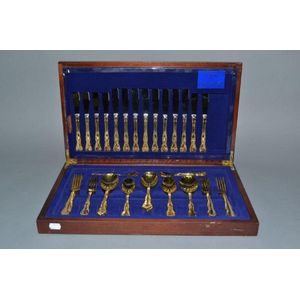Victorian Silver Fish Service with Fern Leaf Engraving
You must be a subscriber, and be logged in to view price and dealer details.
Subscribe Now to view actual auction price for this item
When you subscribe, you have the option of setting the currency in which to display prices to $Au, $US, $NZ or Stg.
- Engraving - The method of decorating or creating inscriptions on silver and other metal objects by marking the surface with a sharp instrument such as a diamond point or rotating cutting wheel.
- Oak - Native to Europe and England, oak has been used for joinery, furniture and building since the beginning of the medieval civilisation. It is a pale yellow in colour when freshly cut and darkens with age to a mid brown colour.
Oak as a furniture timber was superceded by walnut in the 17th century, and in the 18th century by mahogany,
Semi-fossilised bog oak is black in colour, and is found in peat bogs where the trees have fallen and been preserved from decay by the bog. It is used for jewellery and small carved trinkets.
Pollard oak is taken from an oak that has been regularly pollarded, that is the upper branches have been removed at the top of the trunk, result that new branches would appear, and over time the top would become ball-like. . When harvested and sawn, the timber displays a continuous surface of knotty circles. The timber was scarce and expensive and was used in more expensive pieces of furniture in the Regency and Victorian periods. - Flatware - An alternative name for items of cutlery, principally knives, forks and spoons, now generally used to describe sets of these implements. Nowadays it is mostly used when describing cutlery made of silver and silver plate.
It is less frequently used to describe all "flat' items of tableware, so that as well as cutlery the definition includes plates. - Victorian Period - The Victorian period of furniture and decorative arts design covers the reign of Queen Victoria from 1837 to 1901. There was not one dominant style of furniture in the Victorian period. Designers used and modified many historical styles such as Gothic, Tudor, Elizabethan, English Rococo, Neoclassical and others, although use of some styles, such as English Rococo and Gothic tended to dominate the furniture manufacture of the period.
The Victorian period was preceded by the Regency and William IV periods, and followed by the Edwardian period, named for Edward VII (1841 ? 1910) who was King of the United Kingdom and the British Dominions and Emperor of India for the brief period from 1901 until his death in 1910. - Canteen - A small cabinet, table or a box with drawers or lift out trays, for storing a set of cutlery.
This item has been included into following indexes:
Visually similar items

A carved stone chess set (brown & grey), with board, cased, King: 7 cm. Provenance: The collection of the late Dr Thomas James Valentine

Edwardian cased silver dessert service, 12 knives and 12 forks with sterling silver handles, hallmarked Birmingham 1906, maker E. J. Partridge

Silver plate cutlery service 'Grosvenor' in original box, approx 50 cm long, 29 cm wide

An impressive Garrard & Co. Victorian silver gilt dessert service in a bacchanalian design; 36 parfait spoons by Francis Higgins, London 1874; 8 serving spoons, Henry Holland, London 1867; pair of fruit salad servers, Francis Higgins, London 1867/69; grape
